Even in the dead of winter, fresh herbs will add tons of flavor to what ever you’re cooking. For a locavore touch, you can grow them on a sunny windowsill, or when the weather is better, outside in your garden. Here are some of the Accidental Locavore’s favorite herbs, and what to look for:
 Rosemary: Rosemary has silvery-green leaves, and looks a little like pine, but it’s part of the mint family. Rosemary should be healthy looking, green, with a distinct scent. Avoid brown tipped leaves, dry or wilted looking rosemary. Strip the leaves off the stem and it works wonderfully with lamb, potatoes, chicken and veal and is often paired with garlic. If you have big stalks of it, you can use them as skewers for grilling.
Rosemary: Rosemary has silvery-green leaves, and looks a little like pine, but it’s part of the mint family. Rosemary should be healthy looking, green, with a distinct scent. Avoid brown tipped leaves, dry or wilted looking rosemary. Strip the leaves off the stem and it works wonderfully with lamb, potatoes, chicken and veal and is often paired with garlic. If you have big stalks of it, you can use them as skewers for grilling.
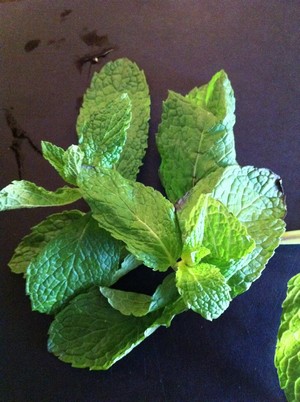 Mint: Mint is in the same family as oregano, sage and basil. There are more than 30 different varieties of mint, the best known being peppermint and spearmint. Mint leaves should be brightly colored with no signs of deterioration (like slimy black leaves). When cutting mint or basil, you need a really sharp knife, otherwise you just bruise the leaves. The best way to cut mint is to strip the leaves from the stem, stack them up, roll them into a tight cylinder, and thinly slice them (a chiffonade). I love it in salads, especially tabbouleh, and it’s one of the secret ingredients that make albondigas or Mexican meatballs taste so good.
Mint: Mint is in the same family as oregano, sage and basil. There are more than 30 different varieties of mint, the best known being peppermint and spearmint. Mint leaves should be brightly colored with no signs of deterioration (like slimy black leaves). When cutting mint or basil, you need a really sharp knife, otherwise you just bruise the leaves. The best way to cut mint is to strip the leaves from the stem, stack them up, roll them into a tight cylinder, and thinly slice them (a chiffonade). I love it in salads, especially tabbouleh, and it’s one of the secret ingredients that make albondigas or Mexican meatballs taste so good.
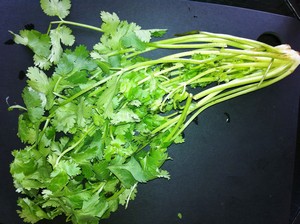 Cilantro: Cilantro looks a lot like Italian flat leaf parsley, but one sniff of it, and you know it’s not parsley! Cilantro is one of those love it or hate it herbs, and since the first time the Accidental Locavore tasted it, I’ve loved cilantro! It’s the key to my amazing guacamole, and salsa verde. If you don’t like it, you probably think it tastes like soap, right? Cilantro will slime quickly so choose it carefully and look for fresh looking bunches, with no wilted or slimy stems. You will often find it sold with the roots on, as Thai and other cultures use the entire plant. If you get a bunch with roots, you can leave them on or cut them off, just make sure to really clean it well, as it tends to be gritty. Storing it in a damp paper towel will help it keep longer.
Cilantro: Cilantro looks a lot like Italian flat leaf parsley, but one sniff of it, and you know it’s not parsley! Cilantro is one of those love it or hate it herbs, and since the first time the Accidental Locavore tasted it, I’ve loved cilantro! It’s the key to my amazing guacamole, and salsa verde. If you don’t like it, you probably think it tastes like soap, right? Cilantro will slime quickly so choose it carefully and look for fresh looking bunches, with no wilted or slimy stems. You will often find it sold with the roots on, as Thai and other cultures use the entire plant. If you get a bunch with roots, you can leave them on or cut them off, just make sure to really clean it well, as it tends to be gritty. Storing it in a damp paper towel will help it keep longer.
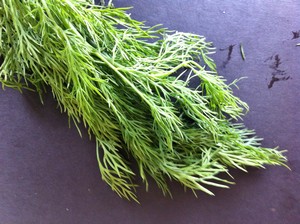 Dill: Dill is most commonly used as the flavoring in pickles. It’s a light, feathery herb with a distinctive smell. Dill is great with fish, especially salmon, and it also works well with lamb. Dill should be light and feathery, with no signs of wilting. Wrapping it in damp paper towels will help preserve it’s life. Dill can be chopped like parsley. It’s great in these little meatballs and egg-lemon soup.
Dill: Dill is most commonly used as the flavoring in pickles. It’s a light, feathery herb with a distinctive smell. Dill is great with fish, especially salmon, and it also works well with lamb. Dill should be light and feathery, with no signs of wilting. Wrapping it in damp paper towels will help preserve it’s life. Dill can be chopped like parsley. It’s great in these little meatballs and egg-lemon soup.
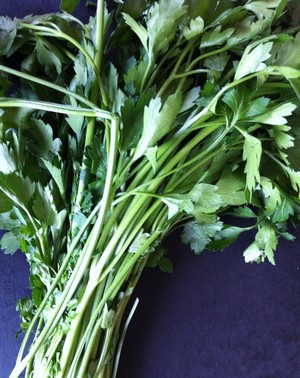 Parsley: Parsley comes both curly and flat leaf. While it’s often dismissed as a garnish, parsley, especially the flat leaf variety has a nice green subtle flavor. It’s great in salads, and as a critical component of a bouquet garni, used to season soups and other hearty dishes. Look for firm, dark green leaves in both varieties, and avoid any wilted looking parsley. Wash it well too, as it may be gritty.
Parsley: Parsley comes both curly and flat leaf. While it’s often dismissed as a garnish, parsley, especially the flat leaf variety has a nice green subtle flavor. It’s great in salads, and as a critical component of a bouquet garni, used to season soups and other hearty dishes. Look for firm, dark green leaves in both varieties, and avoid any wilted looking parsley. Wash it well too, as it may be gritty.
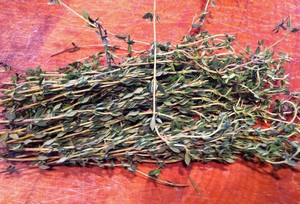 Thyme: Thyme has small almost round leaves on a delicate stem. The aroma should be assertive and bright. There are different varieties of thyme, such as lemon, orange or creeping which is used as a ground cover. For most recipes, the leaves are removed from the stem, however for some soups and bouquet garni, the whole stem is used and removed before serving. Thyme goes well with chicken, fish, and vegetables.
Thyme: Thyme has small almost round leaves on a delicate stem. The aroma should be assertive and bright. There are different varieties of thyme, such as lemon, orange or creeping which is used as a ground cover. For most recipes, the leaves are removed from the stem, however for some soups and bouquet garni, the whole stem is used and removed before serving. Thyme goes well with chicken, fish, and vegetables.

Pingback: Recipe: Lamb Shanks Over Eggplant With Pine Nuts and Yogurt